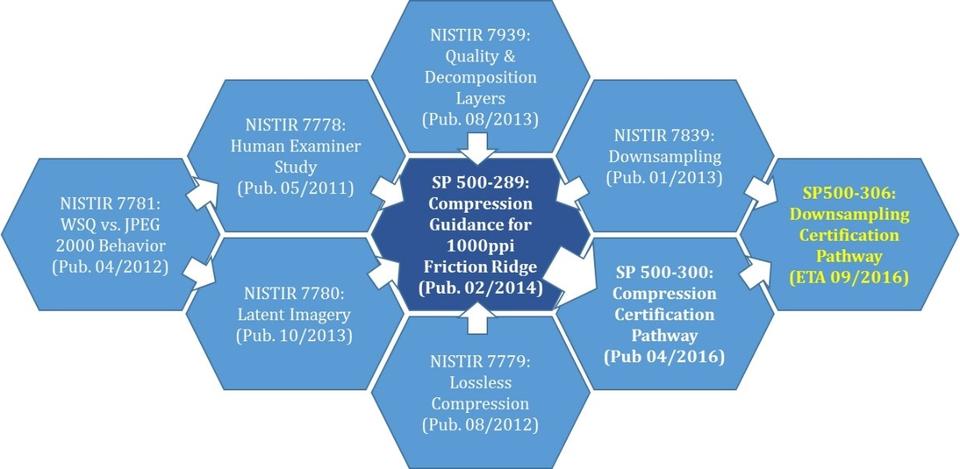Summary
In July of 2009 NIST in partnership with the FBI commenced an investigation on the use of JPEG 2000 for compressing fingerprint imagery with the ultimate goal to establish a normative guidance and certification pathway for the compression of 1000 ppi friction ridge imagery.
Description
Friction Ridge Compression
On February 24, 2014 we proudly announced the release of the final version of this guidance! You can download the final version of the guidance here:
NIST Special Publication 500-289 Final (02/24/2014)
More recently, on April 7, 2016, we're proud to announce the release of a follow-up to our compression guidance in the form of additional guidance on navigating the pathway to certification for JPEG 2000 CODEC's developers, vendors, and other member of the public. You can download the final version of the certification guidance here:
NIST Special Publication 500-300 Final (04/07/2016)
These documents are the result of a culmination of six separate studies spanning thousands of hours of work by many individuals including examiners and various stakeholders. The project team would like to thank you all for helping make this project a success.
Sincerely,
John Libert Shahram Orandi Joey Newell
NIST-ITL-IAD-IG NIST-ITL-IAD FBI-CJIS-BCOE
Background studies that form the basis for SP 500-289 and SP 500-300:
NISTIR 7781: Spectral and PSNR Comparison of WSQ and JPEG 2000 Compression of 500ppi Fingerprint Imagery.
NISTIR 7778: Effects of JPEG 2000 Image Compression on 1000ppi Fingerprint Imagery
NISTIR 7779: A Survey of Lossless Compression Algorithms for 1000ppi Fingerprint Imagery Data.
NISTIR 7839: Down-sampling/'transcoding' strategies.
NISTIR 7939: Effects of Decomposition Levels and Quality Layers with JPEG 2000 Compression of 1000 ppi Fingerprint Images
NISTIR 7780: Effects of JPEG 2000 Image Compression on Latent 1000ppi Fingerprint Imagery
Relationship map for the various background studies feeding into SP 500-289 and SP 500-300:

Background information:
In biometric data processing, data compression is the process of encoding information using fewer bits (or other information-bearing units) than an unencoded representation would use, through use of specific encoding schemes (compression). As with any communication, compressed data exchange only works and the message makes sense when both the sender and receiver of the information understand the encoding scheme applied to the message. Similarly, compressed biometric information can only be understood if the encoding and decoding method is agreed upon and known by all parties involved in the transaction.
The criminal justice communities throughout the world traditionally exchange fingerprint (friction ridge) imagery data primarily in 8-bit gray-scale and at 500 pixels per inch (19.7 pixels per millimeter) using the Wavelet Scalar Quantization (WSQ) fingerprint image compression algorithm.
An emerging class of next-generation systems now support friction ridge imagery at the resolution of 1000 pixels per inch (39.4 pixels per millimeter).
The NIST compression study formalizes a JPEG 2000 compression profile for 1000 ppi friction ridge imagery that can be used by stakeholders to ensure compatibility and utility of these images.

